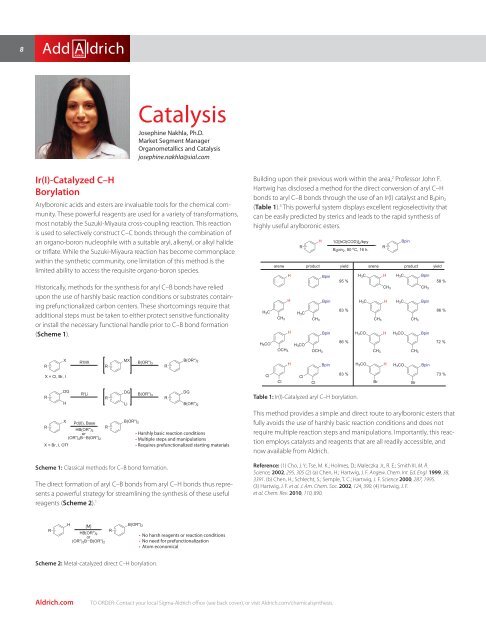Missing out on the latest research developments in ... - Sigma-Aldrich
Missing out on the latest research developments in ... - Sigma-Aldrich
Missing out on the latest research developments in ... - Sigma-Aldrich
Create successful ePaper yourself
Turn your PDF publications into a flip-book with our unique Google optimized e-Paper software.
8<br />
Ir(I)-Catalyzed C–H<br />
Borylati<strong>on</strong><br />
Arylbor<strong>on</strong>ic acids and esters are <strong>in</strong>valuable tools for <strong>the</strong> chemical community.<br />
These powerful reagents are used for a variety of transformati<strong>on</strong>s,<br />
most notably <strong>the</strong> Suzuki-Miyaura cross-coupl<strong>in</strong>g reacti<strong>on</strong>. This reacti<strong>on</strong><br />
is used to selectively c<strong>on</strong>struct C–C b<strong>on</strong>ds through <strong>the</strong> comb<strong>in</strong>ati<strong>on</strong> of<br />
an organo-bor<strong>on</strong> nucleophile with a suitable aryl, alkenyl, or alkyl halide<br />
or trifl ate. While <strong>the</strong> Suzuki-Miyaura reacti<strong>on</strong> has become comm<strong>on</strong>place<br />
with<strong>in</strong> <strong>the</strong> syn<strong>the</strong>tic community, <strong>on</strong>e limitati<strong>on</strong> of this method is <strong>the</strong><br />
limited ability to access <strong>the</strong> requisite organo-bor<strong>on</strong> species.<br />
Historically, methods for <strong>the</strong> syn<strong>the</strong>sis for aryl C–B b<strong>on</strong>ds have relied<br />
up<strong>on</strong> <strong>the</strong> use of harshly basic reacti<strong>on</strong> c<strong>on</strong>diti<strong>on</strong>s or substrates c<strong>on</strong>ta<strong>in</strong><strong>in</strong>g<br />
prefuncti<strong>on</strong>alized carb<strong>on</strong> centers. These shortcom<strong>in</strong>gs require that<br />
additi<strong>on</strong>al steps must be taken to ei<strong>the</strong>r protect sensitive functi<strong>on</strong>ality<br />
or <strong>in</strong>stall <strong>the</strong> necessary functi<strong>on</strong>al handle prior to C–B b<strong>on</strong>d formati<strong>on</strong><br />
(Scheme 1).<br />
R<br />
X<br />
X = Cl, Br, I<br />
R<br />
DG<br />
H<br />
<strong>Aldrich</strong>.com<br />
R'MX<br />
R'Li<br />
R<br />
X<br />
Pd(0), Base<br />
HB(OR'')2<br />
or<br />
(OR'') 2B B(OR'')2<br />
R<br />
X = Br, I, OTf<br />
R<br />
R<br />
MX<br />
B(OR'')3<br />
R<br />
B(OR'')2<br />
DG<br />
B(OR'')3<br />
R<br />
DG<br />
Li B(OR'')2<br />
B(OR'') 2<br />
Scheme 1: Classical methods for C–B b<strong>on</strong>d formati<strong>on</strong>.<br />
Harshly basic reacti<strong>on</strong> c<strong>on</strong>diti<strong>on</strong>s<br />
Multiple steps and manipulati<strong>on</strong>s<br />
Requires prefuncti<strong>on</strong>alized start<strong>in</strong>g materials<br />
The direct formati<strong>on</strong> of aryl C–B b<strong>on</strong>ds from aryl C–H b<strong>on</strong>ds thus represents<br />
a powerful strategy for streaml<strong>in</strong><strong>in</strong>g <strong>the</strong> syn<strong>the</strong>sis of <strong>the</strong>se useful<br />
reagents (Scheme 2). 1<br />
R<br />
H [M]<br />
HB(OR'')2<br />
or<br />
(OR'')2B B(OR'')2<br />
R<br />
B(OR'')2<br />
Scheme 2: Metal-catalyzed direct C–H borylati<strong>on</strong>.<br />
Catalysis<br />
Joseph<strong>in</strong>e Nakhla, Ph.D.<br />
Market Segment Manager<br />
Organometallics and Catalysis<br />
joseph<strong>in</strong>e.nakhla@sial.com<br />
No harsh reagents or reacti<strong>on</strong> c<strong>on</strong>diti<strong>on</strong>s<br />
No need for prefuncti<strong>on</strong>alizati<strong>on</strong><br />
Atom ec<strong>on</strong>omical<br />
TO ORDER: C<strong>on</strong>tact your local <strong>Sigma</strong>-<strong>Aldrich</strong> offi ce (see back cover), or visit <strong>Aldrich</strong>.com/chemicalsyn<strong>the</strong>sis.<br />
Build<strong>in</strong>g up<strong>on</strong> <strong>the</strong>ir previous work with<strong>in</strong> <strong>the</strong> area, 2 Professor John F.<br />
Hartwig has disclosed a method for <strong>the</strong> direct c<strong>on</strong>versi<strong>on</strong> of aryl C–H<br />
b<strong>on</strong>ds to aryl C–B b<strong>on</strong>ds through <strong>the</strong> use of an Ir(I) catalyst and B2p<strong>in</strong>2<br />
(Table 1). 3 This powerful system displays excellent regioselectivity that<br />
can be easily predicted by sterics and leads to <strong>the</strong> rapid syn<strong>the</strong>sis of<br />
highly useful arylbor<strong>on</strong>ic esters.<br />
H 3C<br />
H3CO<br />
R<br />
arene product<br />
CH3<br />
H<br />
H<br />
H<br />
H3C<br />
CH3<br />
H<br />
H3CO<br />
OCH3 OCH3<br />
Cl Cl<br />
Cl<br />
Bp<strong>in</strong><br />
Bp<strong>in</strong><br />
Bp<strong>in</strong><br />
1/2[IrCl(COD)]2/bpy<br />
B2p<strong>in</strong>2, 80 oC, 16 h.<br />
95 %<br />
83 %<br />
86 %<br />
H Bp<strong>in</strong><br />
H3CO H<br />
83 %<br />
Table 1: Ir(I)-Catalyzed aryl C–H borylati<strong>on</strong>.<br />
Cl<br />
R<br />
Bp<strong>in</strong><br />
yield arene product yield<br />
H 3C<br />
H3C<br />
H3CO<br />
CH3<br />
CH3<br />
Br<br />
CH3<br />
H 3C<br />
H3C<br />
H3CO<br />
H3CO<br />
This method provides a simple and direct r<str<strong>on</strong>g>out</str<strong>on</strong>g>e to arylbor<strong>on</strong>ic esters that<br />
fully avoids <strong>the</strong> use of harshly basic reacti<strong>on</strong> c<strong>on</strong>diti<strong>on</strong>s and does not<br />
require multiple reacti<strong>on</strong> steps and manipulati<strong>on</strong>s. Importantly, this reacti<strong>on</strong><br />
employs catalysts and reagents that are all readily accessible, and<br />
now available from <strong>Aldrich</strong>.<br />
Reference: (1) Cho, J. Y.; Tse, M. K.; Holmes, D.; Maleczka Jr., R. E.; Smith III, M. R.<br />
Science, 2002, 295, 305 (2) (a) Chen, H.; Hartwig, J. F. Angew. Chem. Int. Ed. Engl. 1999, 38,<br />
3391. (b) Chen, H.; Schlecht, S.; Semple, T. C.; Hartwig, J. F. Science 2000, 287, 1995.<br />
(3) Hartwig, J. F. et al. J. Am. Chem. Soc. 2002, 124, 390. (4) Hartwig, J. F.<br />
et al. Chem. Rev. 2010, 110, 890.<br />
H<br />
H<br />
H<br />
CH3<br />
CH3<br />
Br<br />
Bp<strong>in</strong><br />
CH3<br />
Bp<strong>in</strong><br />
Bp<strong>in</strong><br />
Bp<strong>in</strong><br />
58 %<br />
86 %<br />
72 %<br />
73 %

















